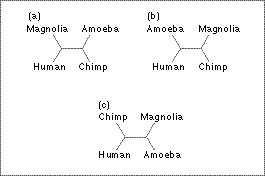The reconstruction of phylogeny - How do we infer phylogeny?

How can we infer the unrooted tree?
Imagine there are four species: human, chimpanzee, magnolia tree and amoeba.
The procedure is as follows:
1. Write out all the possible unrooted trees for the species; that is (a), (b) and (c) shown.
2. Given a knowledge of the character states in each species, count the minimum number of evolutionary events (that is, changes in character states) implied by each. The best estimate of the true unrooted tree is the one requiring the least evolutionary change.
Suppose we know that 1000 characters are shared in all four species, that each species has 10 characters unique to itself and that 100 characters are shared between humans and chimps, but are absent in amoebas and magnolias.
We can now count the smallest number of evolutionary events implied by each unrooted tree.
In (a) the 1000 common characters could have evolved once each in the common ancestor of all four species and been retained throughout the phylogeny; that would require a total of 1000 evolutionary events. Each species' 10 unique characters can have evolved in the lineage leading to that species, making 40 evolutionary events.
The smallest number of events to produce the distribution of characters between humans and chimps is 200: they could have evolved separately in the human lineage and in the chimp lineage (100 events in each, making 200).
1000 + 40 + 200 = 1240 evolutionary events.
The same calculation in (b) also implies 1240 events.
In (c), however, the 100 characters shared by humans and chimps only need to have evolved once, in the common ancestor of humans and chimps, and would not have to be lost again; (c) therefore only requires 1140 events.
(c) is therefore the most parsimonious unrooted tree, and (according to the principle of parsimony) the best estimate of the real unrooted tree.
Figure: possible phylogenetic relationships of amoeba, chimpanzee, human and magnolia.
| Next |



